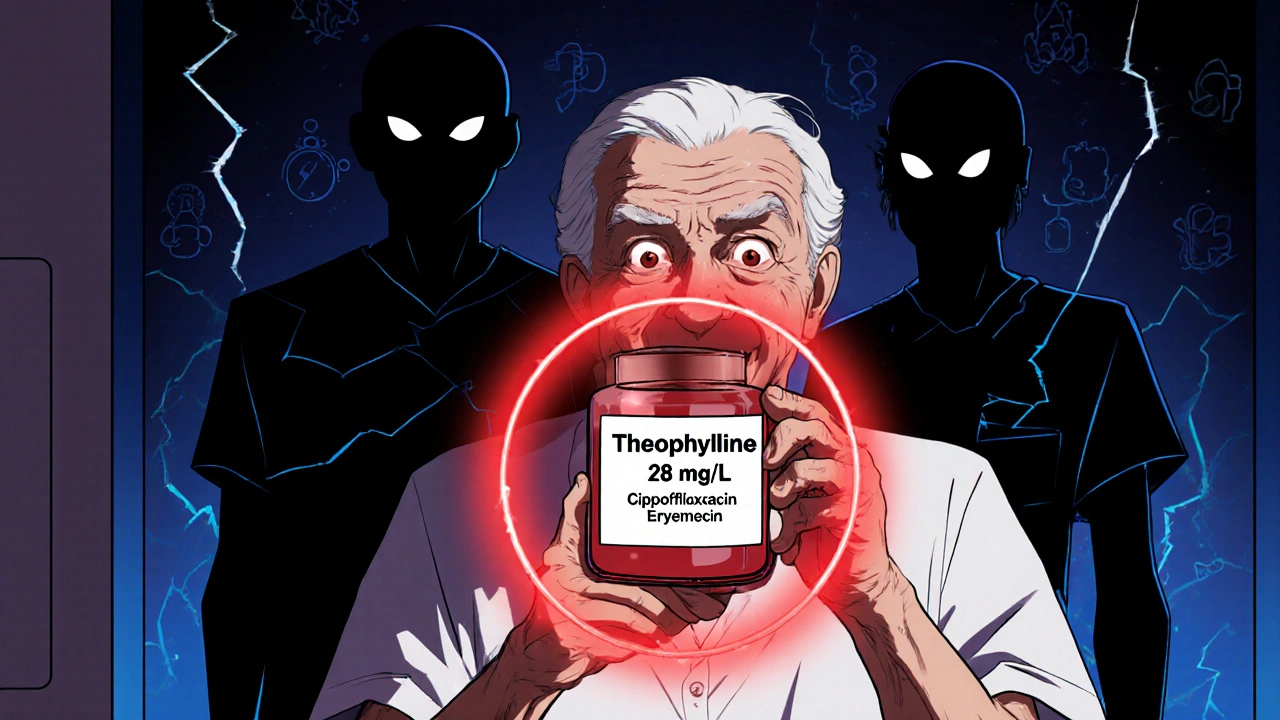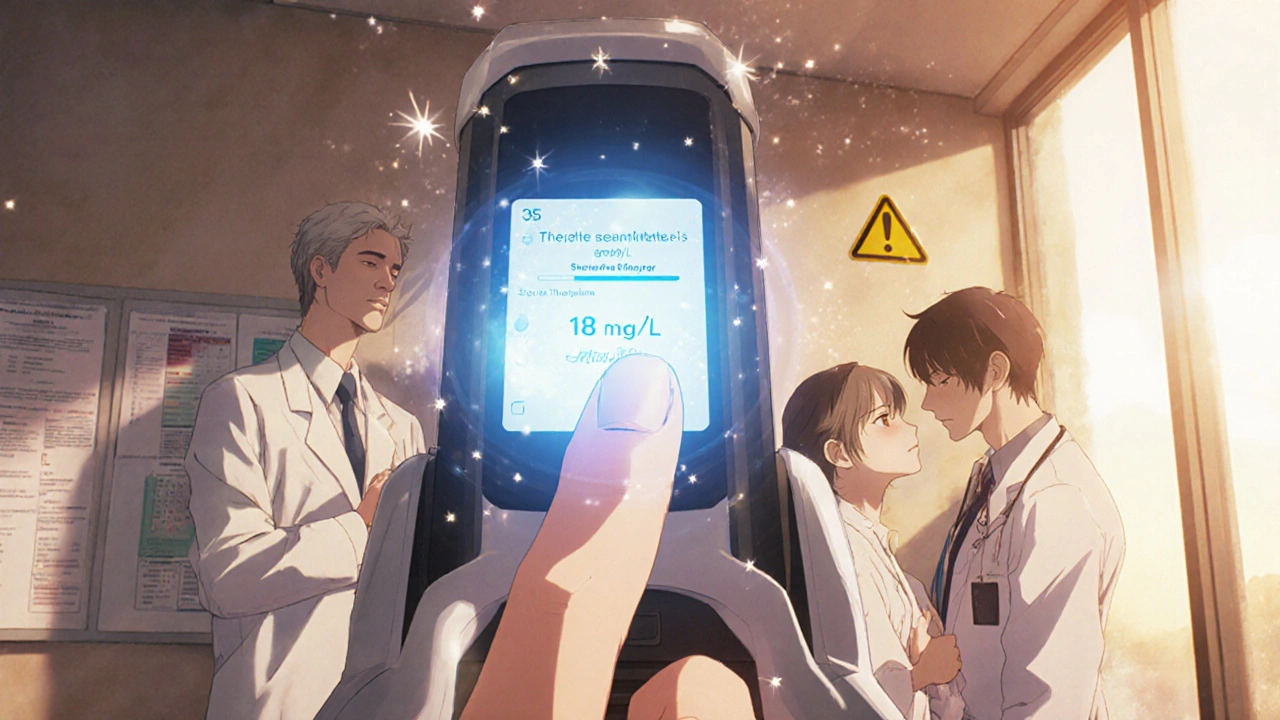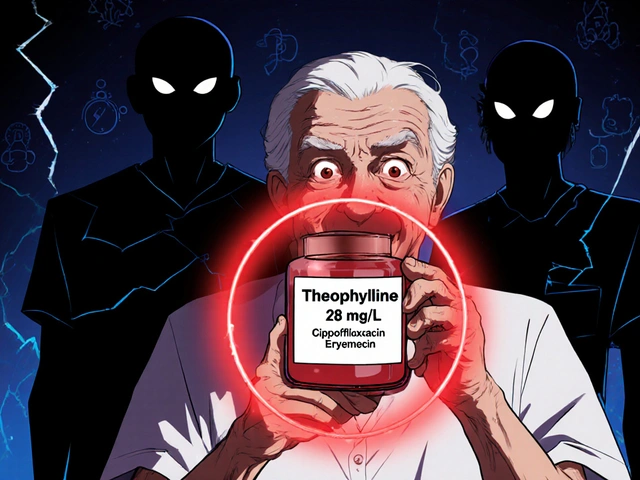
When you take theophylline for asthma or COPD, you’re not just swallowing a pill-you’re walking a tightrope. One milligram too much, and your heart could race out of control. One milligram too little, and your lungs won’t get the relief they need. That’s because theophylline has a narrow therapeutic index-a tiny window between working and hurting you. This isn’t theoretical. It’s life-or-death. And if you’re on this drug, skipping blood tests isn’t an option. It’s negligence.
What Makes Theophylline So Dangerous?
Theophylline has been used since the 1930s to open up airways. It works by relaxing smooth muscle in the lungs and reducing inflammation. But here’s the catch: the difference between a therapeutic dose and a toxic one is razor-thin. The safe range? 10 to 20 mg/L. Go below 10, and it barely helps. Go above 20, and you’re flirting with seizures, irregular heartbeats, vomiting, and even death.
What makes it worse? Your body doesn’t handle theophylline the same way as your neighbor’s. One person smokes, metabolizes it fast, and needs a higher dose. Another is over 60, has liver trouble, and gets toxic from half the dose. Even something as simple as switching from coffee to tea can shift your levels. Alcohol, antibiotics, even herbal supplements like St. John’s Wort can send your concentration soaring-or crashing.
Studies show that about 1,500 Americans end up in the ER each year because of theophylline toxicity. Around 10% of those cases are fatal. And most of them? Preventable.
Why Regular Blood Tests Aren’t Optional
You can’t guess your theophylline level. You can’t feel it. You can’t see it. You need a blood test. And not just once. You need them on a schedule.
When you start the drug, your doctor should check your levels after five days-long enough for it to build up in your system. After any dose change, wait three days and test again. For stable patients, every 6 to 12 months is typical. But if you’re over 60, have heart failure, liver disease, or are pregnant? Every 1 to 3 months. Monthly during the third trimester. No exceptions.
Timing matters, too. For immediate-release tablets, blood should be drawn right before your next dose-this is the “trough” level, the lowest point. For extended-release forms, test 4 to 6 hours after taking it. Mess up the timing, and your result is meaningless.
And don’t assume you’re fine because you’re not feeling sick. A 2023 case in Cureus described a 68-year-old man who started ciprofloxacin for a sinus infection. Within 72 hours, his theophylline level jumped 65%-from 14 mg/L to 28 mg/L. He didn’t feel different until he went into ventricular tachycardia. That’s not rare. That’s predictable.
Drug Interactions: The Silent Killer
Here’s where things get messy. Theophylline is metabolized by your liver’s CYP1A2 enzyme. Anything that blocks that enzyme? It’s a red flag.
- Erythromycin, clarithromycin, ciprofloxacin: These antibiotics can spike theophylline levels by 50-100%. That’s not a side effect-it’s a medical emergency waiting to happen.
- Cimetidine: This old-school heartburn drug? It cuts clearance by up to 40%. Many older patients still take it. Doctors forget to check.
- Allopurinol: Used for gout. Can double theophylline concentration.
On the flip side, some things make theophylline disappear:
- Smoking: Increases clearance by 50-70%. A pack-a-day smoker might need 50% more theophylline than a nonsmoker. Quit smoking? Levels can rise dangerously fast within days.
- Carbamazepine, rifampin, St. John’s Wort: These induce liver enzymes. Your levels drop. You get worse. You might think your asthma is flaring-but it’s your meds.
Doctors who don’t ask about antibiotics, supplements, or smoking habits are setting patients up for failure. And patients? They rarely connect the dots. “I took a Z-pack for my cold,” they say. “I didn’t think it would matter.” But it does.

What Else Should Be Monitored?
Blood levels alone aren’t enough. You need a full picture.
- Heart rate: Over 100 bpm? Could be early toxicity.
- Electrolytes: Theophylline often pairs with albuterol, steroids, or diuretics-all of which can drop potassium. Low potassium makes arrhythmias more likely.
- Neurological symptoms: Headache, tremors, insomnia, irritability. These aren’t “just stress.” They’re warning signs.
- Blood gases: If you’re struggling to breathe, check your oxygen and CO2. Theophylline can mask worsening respiratory failure.
- Full blood count: Rare, but theophylline can suppress bone marrow over time.
And if you’re getting IV theophylline? Never mix it with dextrose. It can cause hemolysis or fake clumping in the IV line. That’s not a myth-it’s a documented risk in the StatPearls database.
Who Still Uses Theophylline Today?
You might think it’s outdated. But it’s not. About 1.2 million people in the U.S. and 850,000 in Europe still take it. Why?
Cost. A month’s supply of generic theophylline runs $15-$30. Compare that to biologics like omalizumab or mepolizumab-$200-$400 a month. In rural clinics, in developing countries, or for uninsured patients, theophylline is often the only viable option.
It’s also still used in severe asthma when inhaled steroids and long-acting bronchodilators aren’t enough. New research shows it helps restore HDAC2 activity, which reduces inflammation in hard-to-treat cases. That’s not just bronchodilation-it’s disease modification.
But here’s the paradox: the same people who benefit most from theophylline are the ones least likely to get monitored. Elderly patients with multiple meds. People with poor access to labs. Those who can’t afford frequent blood draws. That’s why toxicity cases are rising-up 23% per year from 2020 to 2023, mostly in seniors with undiagnosed liver or kidney problems.

What’s Changing? What’s Coming?
There’s hope on the horizon. Three companies-TheraTest Diagnostics, PharmChek Solutions, and RapidTherapeutics-are testing handheld devices that can measure theophylline levels in under five minutes using a finger-prick sample. Imagine walking into your pulmonologist’s office, getting a quick test, and walking out with a dose adjustment the same day.
But until those devices are FDA-approved and widely available, the standard hasn’t changed. The American College of Chest Physicians says it clearly: “Traditional serum concentration monitoring remains the standard of care.” No shortcuts. No exceptions.
Real Results: When Monitoring Works
A 2022 study in the Journal of Asthma followed 300 patients on theophylline in a community hospital. Before they started a formal monitoring protocol, 1 in 4 had an adverse event within six months. After implementing regular blood tests, dose adjustments, and patient education? Adverse events dropped by 78%. Asthma control scores improved by 35%.
Patient feedback? On forums like Asthma UK, 82% of users said their symptoms were better when levels were in range. But 37% admitted they hated the frequent blood draws. That’s understandable. But they also said: “I’d rather get poked than end up in the ER.”
And here’s the truth: if you’re on theophylline, you’re not just managing asthma. You’re managing a high-risk medication. That’s not fear-mongering. That’s science.
What You Should Do Right Now
- If you’re on theophylline, know your last blood level. Ask your doctor for a copy.
- Make a list of every medication, supplement, and herb you take. Bring it to every appointment.
- Don’t start or stop smoking without telling your doctor. That change alone can alter your dose.
- Never take a new antibiotic without asking: “Will this affect my theophylline?”
- If you feel shaky, nauseous, or your heart is racing-get checked. Don’t wait.
Theophylline isn’t going away. It’s too useful. Too cheap. Too effective for too many people. But its power comes with responsibility. Monitoring isn’t bureaucracy. It’s the line between breathing easy and fighting for your life.
How often should theophylline levels be checked?
Initial testing should occur 5 days after starting treatment or 3 days after any dose change. For stable patients, every 6-12 months is typical. But if you’re over 60, have heart or liver disease, are pregnant, or have recently started a new medication, you may need testing every 1-3 months-or even monthly during pregnancy.
What happens if my theophylline level is too high?
Levels above 20 mg/L increase the risk of side effects. Above 25 mg/L, toxicity becomes likely. Symptoms include nausea, vomiting, tremors, rapid heartbeat, seizures, and life-threatening arrhythmias. If your level exceeds 20 mg/L, your doctor will reduce your dose immediately and may admit you for monitoring. Levels over 30 mg/L require emergency treatment.
Can I skip blood tests if I feel fine?
No. Theophylline toxicity doesn’t always cause symptoms until it’s too late. You can feel perfectly normal while your levels creep into the danger zone-especially if you start a new antibiotic or quit smoking. Blood tests are the only reliable way to know your level.
Does smoking affect theophylline levels?
Yes. Smoking increases how fast your body clears theophylline by 50-70%. That means smokers often need higher doses. If you quit smoking, your levels can rise dangerously within days. Always tell your doctor if you start or stop smoking.
Are there any alternatives to theophylline?
Yes-inhaled corticosteroids, long-acting beta-agonists, and biologics like omalizumab are now preferred for most patients. But theophylline is still used when those don’t work, especially in low-resource settings or for severe asthma that doesn’t respond to other treatments. Its low cost keeps it relevant.
Can I take theophylline with other medications?
Some medications are dangerous to take with theophylline. Antibiotics like erythromycin, clarithromycin, and ciprofloxacin can cause toxic buildup. Other drugs like carbamazepine or St. John’s Wort can make theophylline less effective. Always review your full medication list with your doctor or pharmacist before starting anything new.



lol why are we still using this 1930s relic? my grandma took this and nearly died. they should just ban it already. if you need a blood test every week just to not die, maybe it's not a drug, it's a gamble.
i've seen this in rural india too. patients on theophylline because biologics are out of reach. but no one checks levels. i had a patient who took cipro for a cough and ended up in ICU. it's not the drug's fault-it's the system. we need community labs, not just hospital ones.
sooo... if i drink tea instead of coffee i might OD? and if i quit smoking i might as well write my obituary? this drug sounds like a cursed amulet. someone please tell me i can just switch to vape and call it a day.
This is an essential public health message. Theophylline requires rigorous monitoring. Any deviation from established protocols constitutes a breach of the standard of care.
USA is so backwards. In Canada we just give inhalers and call it done. Why are we still playing Russian roulette with pills from the stone age? This is why healthcare sucks here.
I’ve been thinking about this a lot lately-how medicine has become this fragile dance between chemistry and chaos. Theophylline isn’t just a drug-it’s a mirror. It reflects our neglect, our assumptions, our laziness. We treat it like a toaster: plug it in, forget it, hope it works. But it’s not a toaster. It’s a live wire in a wet basement. And we’re the ones holding the plug. Every time someone skips a test, it’s not just risk-it’s a quiet surrender to the myth that ‘I feel fine’ means ‘I’m fine.’ We’ve forgotten that medicine isn’t about how you feel-it’s about what the numbers say. And when the numbers lie, people die. And it’s not tragic. It’s avoidable. And that’s the real horror.
Cipro + theophylline = bad news. Saw a case last month. Patient thought antibiotics were safe. Didn't know. Ended up in ICU. Always ask your pharmacist. Seriously. They know more than your doctor sometimes.
Theophylline's narrow therapeutic index (NTI) mandates pharmacokinetic surveillance due to its non-linear metabolism and high inter-individual variability in CYP1A2-mediated clearance. Failure to adhere to TDM protocols constitutes a clinically significant deviation from evidence-based guidelines per ACCP 2021.
I remember in my early days as a junior doctor in London, we used to call theophylline 'the silent assassin'. One patient, brilliant woman, 72, on it for decades. Took a course of erythromycin for bronchitis. Didn't tell anyone. Next morning, found her in the corridor, shaking, heart rate 160. We got her level: 34. She lived. But barely. That was 1998. And here we are, still having the same conversation. It's heartbreaking.
I work in a clinic where patients can't afford labs. We have one machine that does theophylline levels, and it breaks every other week. We tell people to come back in two months. But what if they don't come back? What if they die? We need funding. We need help. This isn't just about medicine-it's about justice.
My dad was on this for years. We did the blood tests religiously. He said he'd rather get poked than end up in the ER. And honestly? He was right. I wish more people knew that. 💪
I used to think this was overkill. Then my cousin had a seizure. Turns out he was on theophylline and started taking an OTC cold med. No one told him it could kill him. I just... I don't know what to say. This needs to be louder.
In Nigeria, we use theophylline because it's affordable. But we lack monitoring infrastructure. We need mobile labs, community health worker training, and simple educational pamphlets in local languages. This isn't just a medical issue-it's a public health emergency waiting to explode.
You people are being dramatic. Theophylline has been used for 90 years. If you can't handle it, don't take it. My uncle took it for 40 years, smoked like a chimney, never checked levels, and lived to 87. Meanwhile, you're all terrified of a molecule. Modern medicine is so weak. You need a blood test for everything now? Pathetic. 😒
If you're on this drug and you're not getting tested every month, you're a fool. And if your doctor isn't telling you this, find a new one. This isn't hard. It's basic. Stop being lazy. People die because of this.